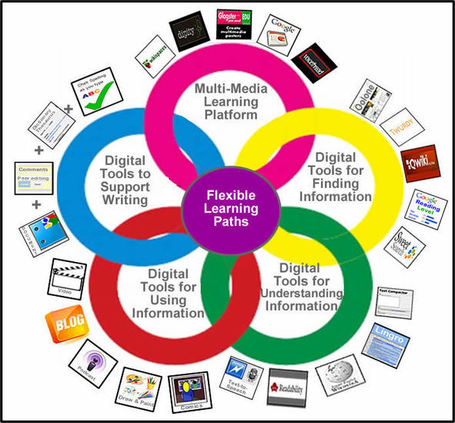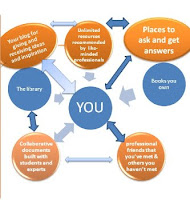
This is How We Dream, Parts 1 and 2
Dr. Richard Miller, professor of English at Rutgers University, in his 2008 lecture paints a compelling change within the art of communication. The book, as a single print based document is easily doomed to virtual extinction and is not easily shared by a mass audience. Our forms of communication are rapidly changing but to what extent is yet to be fully realized. What was the reference book in the library is now becoming a web based document. Its original format was a print document similar to the book. But it goes a step further when sound and visuals are incorporated. Now this newer form of multimedia communication is shared instantaneously and globally and collaboratively. It can be amended as change occurs making it a living and freely shared document.
These are the references today's students are exploring and creating. Knowledge is available at a keystroke. The student needs only access it from a computer, tablet, or notebook right at their desk. This very well could signal the end of the typical library and possibly even the dependency on pens and paper. Perhaps I am old fashioned but I see a need for these basic tools to coexist along with emerging technologies.
With the trained and inspiring teacher's assistance the student's reach is virtually limitless. Learning to use and also create and freely share multimedia is imperative. He touched on a few still developing technologies that will soon be involved in global communication. It is going to take me a while to grasp the concept of digital composing, or using the web itself to gather data.
Dr. Miller states that he too is struggling with this concept and where it is heading. He points out what is needed in the school system is:
"Inspiring Teachers of New Media Composition, Ubiquitous Composing Technology, Pedagogues that Inspire Collaboration and Creativity, and Spaces that Foster Collaborative Learning."
This was an impressive statement and it sent me on an online search right away. Ubiquitous means: to seem to be everywhere at once. Pedagogues means: the work of the teacher, education. And that is where my classmates and I enter into Dr. Miller's lecture. We must be prepared to inspire and guide our students into these emerging technologies some of which have yet to be created. I can see how the interest in classroom blogging will soon evolve into collaborations of shared global experiences and learning on a daily basis. This first technological step paves the way for more web based involvement and creativity. Professor Miller makes it very clear that the restrictions we face are the ones that we place on ourselves. Today's student is not apprehensive of technology. They have already embraced it for years. The teacher and student can now operate as a creative team where each one has something to give and receive.
Carly Pugh's Blog Assignment #12
In her blog #12 Miss Pugh is instructed to create an assignment
within her area of expertise that is similar to those her instructor, Dr. Strange, has been giving during the semester. She will be writing the instructions and then following them. What Miss Pugh ultimately creates could be delivered at a teacher's convention. I felt like she was speaking directly to me, not simply delivering an assignment. Her tone is witty and her goals are well thought out and clearly presented.
Her post delivers on several points from Dr. Miller's
How We Dream movie. It is a web based document composed from materials found on the web and includes value-added visual and sound clips. Miss Pugh has invested a lot of time during her semester researching and creating a playlist on YouTube what she considered to be the most interesting and relevant videos to share with her students and classmates. She has a definite plan for diversity, creativity, and entertainment through the use of her playlist. According to Dr. Miller's movie, Miss Pugh seems to be the much needed inspiring teacher using new media technologies with a plan to inspire creativity within her classroom.
Thoughts for an EDM310 video
Two movies made for EDM310,
The Chipper Series and
EDM310 for Dummies, deliver the not so subtle message that diligence, timeliness and hard work are the key to surviving the EDM310 course. Poor Chipper with her quick fixes, forecasting, and know it all attitude is an interesting character but also tragic. She wastes so much time before finally getting her head on straight. While there is still no tell-all book with all the answers for making EDM310 easier there are plenty of other resources: assistants, classmates, and acquired professionals we have followed on Twitter. So no matter how overloaded I may feel at times I am happy with the fact that I am not going to have to go it alone.
Imagine a video series made by enthusiastic, eager, freshly self-trained EDM310 students (picture a super hero) that targets established teachers and helps them become a little more technologically literate. The teacher who is not comfortable with her whiteboard is given a few fun pointers and suddenly math and science lessons are not so boring. The teacher with classroom computers but no blogging skills has a few EDM-ites swoop in and set up a class blog and demonstrate how much fun it is to get comments on their work from people from around the world. Yet another classroom is instructed on making a podcast and publishing it to their class blog. Imagine a class being shown how to have a meaningful Skype session with another class in Australia. Cue-
"It's a Small World" music score!
Once these little seeds of creativity are planted in various classrooms we see morale increasing, technology being implemented, teachers sharing these ideas with other teachers and students interest in technology turned on. EDM310 has now gone past it's own lab and into real classrooms and made a difference...even before we have graduated.
Now what would be a good costume for the EDM-ite hero?
Learn to Change, Change to Learn
There are times when seemingly good ideas simply do not deliver the desired results. When a concept is tried and deemed unsuccessful then it is time to pack it away and look for a better solution. As stated in this 2008 video by the
Pearson Foundation our classrooms are falling behind on producing graduates that are suited for the real world. Today's employee needs to be collaborative, multi-disciplined, multicultural, a problem solver, highly communicative, skilled at finding information, and creative. An intelligent student and employee is one dimensional and underdeveloped. The
No Child Left Behind Act of 2001 and standardized testing have not improved the quality of education nor a more well rounded high school graduate. What has been documented is an increased rate of overall failures with school standards, time-lines and goals.
Wherever there is a more interesting, creative, communicative world it is there that the most attention and time will be focused. Right now this is not found in the typical classroom. Cell phones are off limits and computers are scarce. I agree with the speaker who stated that change needed to start with the teachers being given the technology to connect with other teachers worldwide for collaborative purposes. Social networking can be as enriching and creative inside the classroom as outside. There is more to be gained by a community than an individual.
If this video is deemed an 'attack' on the way schools are operated then so be it. The current plan simply has not work in the long run. According to this video there are many organizations and individuals pushing for change and spearheading technology inclusion into the classroom. Where there is change there is hope for a brighter tomorrow.
Scavenger Hunt 2.0
I began the scavenger hunt by watching the
Discovery Education Web 2.0 video on Justin Cometti's blog. The
WEB 20.12 site and tool section was start of the actual hunt.
First stop: Community Tools to look for a site similar to Twitter and Facebook that will work as a social platform for teachers, student and parents. I chose
Edmodo to be my
Kingdom's communication site with students and parents. We are now referred to as The Royal Realm. Here they will find classmates pictures, completed projects, homework, and news of The Royal Court. For social networking with other educators around the world I have set up The Aristocracy. Here we can share ideas and swap dragon recipes.
Second stop: $$. Edmodo is a free social networking site which is quite convenient since so Kingdom's coffers are lacking these days. Edmodo is available in a
teacher or student format.
Third stop: Find a video tool that is new to me. I chose
Prezi which can be found in Presentation Tools. A Prezi is a presentation format that is visually dynamic, active, collaborative, easy to use, and best of all it can be FREE. The free Prezi is stored in the pubic domain. For privacy concerns Prezi has a
pricing scale.
Fourth stop: Create a poll at
Poll Everywhere which can be found in Mobile Tools. This site is FREE for audiences of 40 or less and has a sliding scale for larger groups. I chose an open-ended poll rather than multiple choice for a larger variety of responses This poll was placed on my Facebook and Twitter sites.














